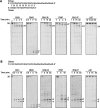The role of the S1 domain in exoribonucleolytic activity: substrate specificity and multimerization
- PMID: 17242308
- PMCID: PMC1800512
- DOI: 10.1261/rna.220407
The role of the S1 domain in exoribonucleolytic activity: substrate specificity and multimerization
Abstract
RNase II is a 3'-5' exoribonuclease that processively hydrolyzes single-stranded RNA generating 5' mononucleotides. This enzyme contains a catalytic core that is surrounded by three RNA-binding domains. At its C terminus, there is a typical S1 domain that has been shown to be critical for RNA binding. The S1 domain is also present in the other major 3'-5' exoribonucleases from Escherichia coli: RNase R and polynucleotide phosphorylase (PNPase). In this report, we examined the involvement of the S1 domain in the different abilities of these three enzymes to overcome RNA secondary structures during degradation. Hybrid proteins were constructed by replacing the S1 domain of RNase II for the S1 from RNase R and PNPase, and their exonucleolytic activity and RNA-binding ability were examined. The results revealed that both the S1 domains of RNase R and PNPase are able to partially reverse the drop of RNA-binding ability and exonucleolytic activity resulting from removal of the S1 domain of RNase II. Moreover, the S1 domains investigated are not equivalent. Furthermore, we demonstrate that S1 is neither responsible for the ability to overcome secondary structures during RNA degradation, nor is it related to the size of the final product generated by each enzyme. In addition, we show that the S1 domain from PNPase is able to induce the trimerization of the RNaseII-PNP hybrid protein, indicating that this domain can have a role in the biogenesis of multimers.
Figures




References
-
- Amblar, M., Arraiano, C.M. A single mutation in Escherichia coli ribonuclease II inactivates the enzyme without affecting RNA binding. FEBS J. 2005;272:363–374. - PubMed
-
- Amblar, M., López, P. Purification and properties of the 5′-3′ exonuclease D190→A mutant of DNA polymerase I from Streptococcus pneumoniae . Eur. J. Biochem. 1998;252:124–132. - PubMed
-
- Amblar, M., Lacoba, M.G.D., Corrales, M.A., López, P. Biochemical analysis of point mutations in the 5′-3′ exonuclease of DNA polymerase I of Streptococcus pneumoniae. Functional and structural implications. J. Biol. Chem. 2001;276:19172–19181. - PubMed
-
- Amblar, M., Barbas, A., Fialho, A.M., Arraiano, C.M. Characterization of the functional domains of Escherichia coli RNase II. J. Mol. Biol. 2006;360:921. - PubMed
-
- Andrade, J.M., Cairrão, F., Arraiano, C.M. RNase R affects gene expression in stationary phase: Regulation of ompA. Mol. Microbiol. 2006;60:219–228. - PubMed
Publication types
MeSH terms
Substances
LinkOut - more resources
Full Text Sources
Molecular Biology Databases
Miscellaneous
